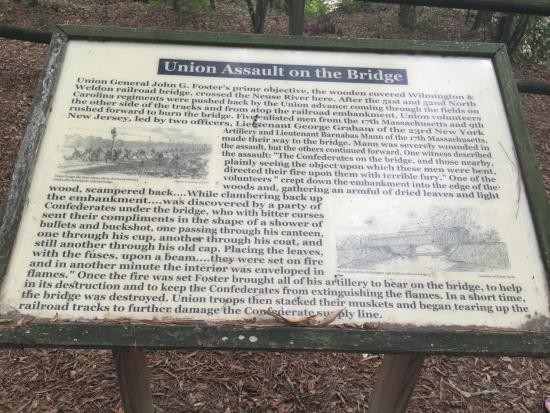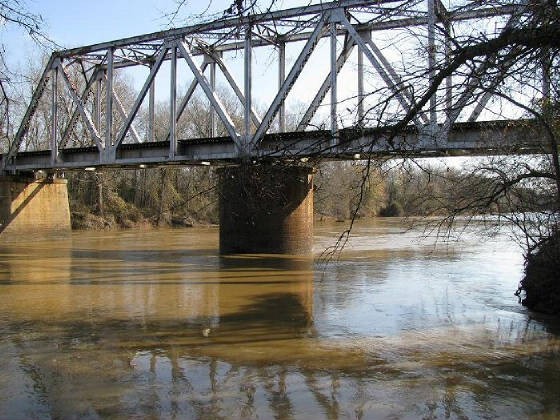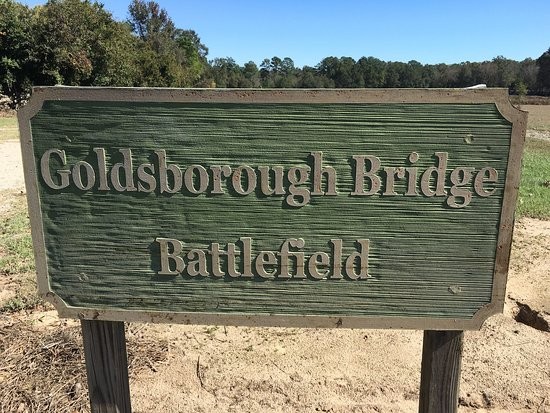Goldsborough Bridge Battlefield
Introduction
Text-to-speech Audio
Images
Union Attack on the Bridge

Goldsborough Bridge

Goldsborough Bridge Battlefield

Backstory and Context
Text-to-speech Audio
Goldsborough Bridge Battlefield marks the location where 15,000 soldiers fought during the Last Battle of Foster’s Raid, at a vital moment of the Civil War in the year of 1862. The battlefield is named after the actual Goldsborough bridge that gives way to railroad crossing of the Neuse River. During the civil war this crossing was used Wilmington & Weldon Railroad to move both supplies and men from the deep south to aide their counterparts in Virginia. In the winter of 1862, union armies, recognizing the importance of this bridge to the Confederacy, began planning an attack to stifle the counter armies supply lines.
The scheduled attack to be led by General J.G. Foster, would be carried out as part of a two-part battle drawn up by Union planners in Washington D.C. The initial part of this battle would be carried out by Gen. Ambrose E. Burnside and the Army of Potomac who would attack Gen. Robert E. Lee. Union leadership, expecting General Lee and the Army of Northern Virginia to be defeated at Fredericksburg, believed that a defeated army without supply or support from the railroad deliveries would be unable to retaliate changing the tide of the war.
The North Carolina portion of the battle began on December 11, 1862, when Gen. Foster marched inland from coastal New Bern with 10,000 infantrymen, 640 mounted troops, and 40 pieces of artillery. Fighting ensued the following day at Vine Swamp and continued at several locations (Southwest Creek, Kinston, and White Hall) through the 16th of the month. The Confederates being outnumbered and unequipped for these battles were defeated at every turn allowing Foster to approach Goldsboro by the morning of December 17th. The battle began soon after with Gen. Foster unloading cannon fire into the woods lining the trails to the bridge to clear the Confederate soldiers and causing them to retreat and push back to the banks of the Neuse River. After battling 2 hours the union forces approached the bridge, and sent Union volunteers to set the bridge ablaze covered by artillery fire that foiled the Confederates attempts to put out the fire.
Though Foster had accomplished the original mission, the battle did not end before having to also overcome a Confederate counterattack ordered by an infuriated Confederate General Nathan Evans. Evans ordering Clingman (leading the defeated Confederate forces at Goldsborough) to send his men to engage with the rear Union guard. The Union armies were leaving the battlefield when men of both Evans and Clingmans armies appeared with flags shouting the rebel yell prepared to strike. During this time, Confederate soldiers simultaneously broke a dam on a millpond to cut the Union rear guard off from the bulk of their forces. However additional Union reinforcements had already arrived. Thought the Union soldiers would have to wade neck deep across this stream at the end of this battle, they did so with a victory defeating the Confederates once again before leaving.
Thought the Battle at Goldsborough Bridge was a Union victory it failed to impact the Confederate forces as desired due to Gen. Burnside being defeated very badly by Gen. Lee’s armies in Fredericksburg. While Gen. Foster claimed a victory, he left nearly 1,300 combined causalities in his wake. With Confederate forces, still strong in Virginia the Goldsborough bridge was rebuilt in a matter of weeks restoring the connection of supplies and men from the deep south and the port at Wilmington to Virginia Confederate forces.
Sources
Goldsborough Bridge Battlefield Association. History. Goldsborough Bridge Battlefield. Accessed February 19, 2017. http://www.goldsboroughbridge.org/history.asp.
Cox, Dale. Goldsborough Bridge Battlefield. ExploreSouthernHistory.com. Accessed February 18, 2017. http://www.exploresouthernhistory.com/goldsborough.html.
